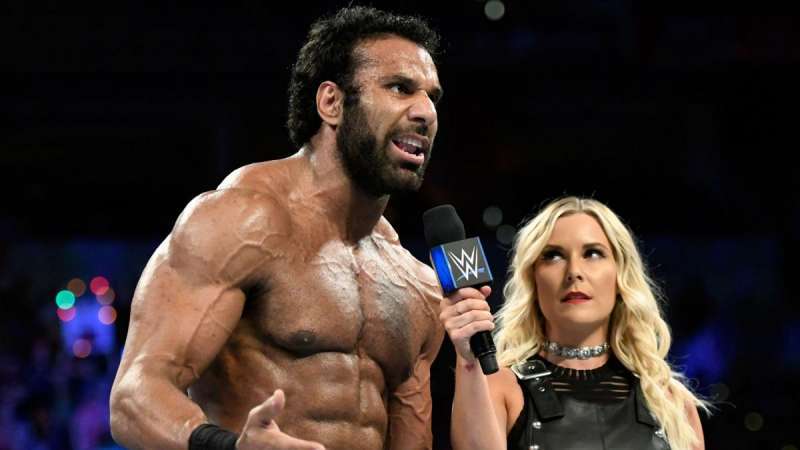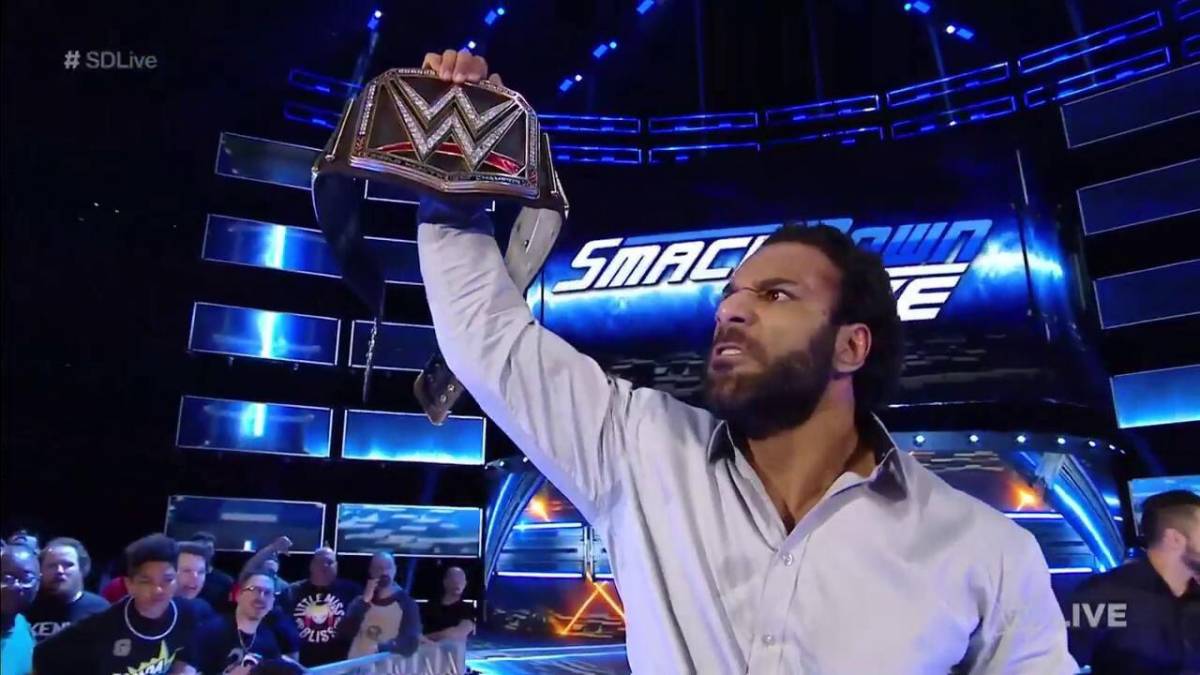At WWE’s latest Smackdown Live brand exclusive pay-per-view, Backlash, the company went all in on their latest experiment and crowned the unlikely Jinder Mahal the new WWE Champion – with a pinfall victory over Randy Orton. The man at first seemed like post-Mania cannon fodder when anointed number one contender, in line with John Cena to Brock Lesnar in 2003 and Ryback to Cena himself in 2013.
In essence, he was an unexpected contender for the champion to mow down. Sure he had been built strongly in the wake of his unlikely push. The Singh Brothers were at his side and he essentially got the best of Orton at every turn in the build up to the title bout. But seeing this through and actually putting the belt on Mahal is another story entirely. The story that is about to unfurl on Tuesday nights has more in line with JBL’s monster push in 2004 than Ryback four years ago. Jinder Mahal as WWE Champion could well be here to stay. It’s a brave, bold move no one would have seen coming a little over a month ago – and here is why this is both good and, potentially, very bad for WWE.
Change in professional wrestling is a good thing. What irks large portions of the online community is when that change doesn’t fall in line with their own expectations. Randy Orton was probably the WWE Champion of choice for very few in 2017, so a fresh face is clearly a good idea. Would people have been as up in arms about Jinder Mahal receiving this push if it was someone like Sami Zayn receiving mega-star treatment? Probably not. Sure, there’s the arguments of whether or not the star in question has “paid their dues” in the business, whether they have wowed the world on the independent circuit and whether or not they were once in a comedy stable of incompetent musicians. But what do we, as fans, really know about all of the above?

Mahal’s peers have come forward on Twitter to congratulate the man, to confirm he has indeed “paid his dues”, and to show support for the fact he has been able to wash off the stain of the Three Man Band. Mahal may not have the extensive back catalogue of excellent matches that someone the calibre of Zayn has,in fact he’s never had a match that’s been above average, but that doesn’t mean it won’t come with time. What matters most in the early days of this angle is that WWE now commits to it fully to invest people in the story being told – the match quality can then follow.
As noted above, Mahal’s sudden ascent to the WWE Championship is eerily reminiscent of the rise of JBL in 2004. In both then and 2017, the Smackdown brand was devoid of a top heel to either challenge a babyface champion or take on the reigns himself. This year saw both Bray Wyatt and The Miz, top heel stars ever since the 2016 brand split, traded over to Monday Night Raw. On top of this, AJ Styles has turned face by proxy, Shinsuke Nakamura could be debuted as nothing but a fan favourite and John Cena will more than likely never turn heel. Sure, Smackdown Live picked up the sensational Kevin Owens. But with him came the United States Championship and a happy desire to make that belt relevant once more, meaning the new face of America may not be near the WWE title scene any time soon. Randy Orton needed a challenger and Smackdown Live needed a heel – in steps Jinder Mahal.
There is a line of thought that Smackdown tends to succeed with a heel champion in place. Many point to the aforementioned JBL’s monster run with the title in 2004 and into 2005, and the unexpectedly entertaining “Hall of Pain” era with Mark Henry as World Heavyweight Champion in 2011 as examples of this. It is still the early days of the era of the Modern Day Maharaja but, if booked correctly and believably, Mahal’s title run could mirror that of both Bradshaw and Henry.

WWE
There is clearly no shortage of challengers on the Smackdown Live roster, and with the likes of Styles, Nakamura and Zayn in that category there’s also no reason the match quality come bell time won’t be a vast improvement over what we saw Sunday night at Backlash. On top of this there’s the thinking that if Mahal can be pushed seemingly from nowhere and win the brand’s top prize, why couldn’t anyone else? This air of unpredictability makes for good episodic television and, coupled with the fact Smackdown is now established as a live show, helps create an environment in which anything could happen at any time. Maybe, just maybe, Jinder Mahal as WWE Champion could work.
There are, however, potential downsides to the meteoric rise of Jinder Mahal. The first, unlike JBL or Mark Henry, is character specific. Mahal represents, to many, a tired and old wrestling cliché – the evil foreign villain come to ruin everything Americans hold so dear. Whilst this has undoubtedly worked in the past, otherwise it wouldn’t have become the trope it is today, the question isn’t “will it still work in 2017?” – the question is “should we still be portraying this character in 2017?”
WWE is, now more than ever, a worldwide brand. A character arriving to run down the United States isn’t something a large part of the audience will care about, quite frankly. A WWE fan in Scotland, Spain or Singapore probably couldn’t care less about what Jinder Mahal thinks of American people, towns or values. Whilst the company has of course had a large presence across the globe for some time, in 2017 it’s simply a tired story that doesn’t translate as well as it once did. Add on top of this the fact Mahal is using words like “holy” and talking about being a peaceful man until he is angered and you have potential for a tasteless angle that could well go the way of Muhammad Hassan in 2005.
On a broader scale, Mahal being plucked from nowhere to be WWE Champion undercuts a large part of fan investment in the characters WWE puts forward onto television. Traditionally, a character will follow a pre-determined path through several feuds, potentially a tag team venture or a mid-card title run before ascending to the main event scene. Whilst Mahal’s first WWE run did feature some of the above, very little of it can be considered successful and the early days of his return to the company last year didn’t suggest this time around would be any different. Whilst Mahal is far from the first WWE superstar to receive a push from nowhere, this approach can be said to lessen fan interest not only in the individual but in the product as a whole.

WWE
Why should fans buy into a character, feel for every win and every loss, cheer them or boo them as they make their way up the ladder, when the company can simply pick someone from nowhere instead? In essence, this approach means that it doesn’t matter who you like or dislike because WWE has the final say. Whilst the opposite approach, allowing fans to essentially rule the entire show, is a step too far in the other direction, surely a middle ground would make for higher levels of fan investment. The argument could be made that, because the character is a heel, this is null and void as fan dislike will translate into the type of heat WWE wants to character to garner. This in itself may be true, but it’s how such booking effects the rest of the roster that needs to be considered. Why would anyone care for any of Shinsuke Nakamura’s wins, losses, feuds, injuries, near misses and epic moments when, at the end of the day, he’ll be pushed when WWE wants to push him and the audience will have to sit down, shut up and accept it?
As with everything in professional wrestling, we won’t be able to judge the success of Jinder Mahal until several months from now. Will this be remembered as a door opening for new, underused talent and the ushering in of fresh faces on Smackdown Live? Will WWE ruin it by pushing the racial envelope too far and have Jinder disappear as quickly as he arrived? Will Randy Orton easily crush him at Money in the Bank and prove the whole thing to be a publicity stunt? Or, against all odds, will Jinder Mahal develop into a believable, watchable WWE Champion with interesting angles and intriguing matches deep into 2017 and beyond?
On Sunday May 21st at Backlash WWE got the wrestling universe talking about Jinder Mahal, the new WWE Champion. Now it’s time to see if any of those conversations were worthwhile.
Some of the coverage you find on Cultured Vultures contains affiliate links, which provide us with small commissions based on purchases made from visiting our site. We cover gaming news, movie reviews, wrestling and much more.



